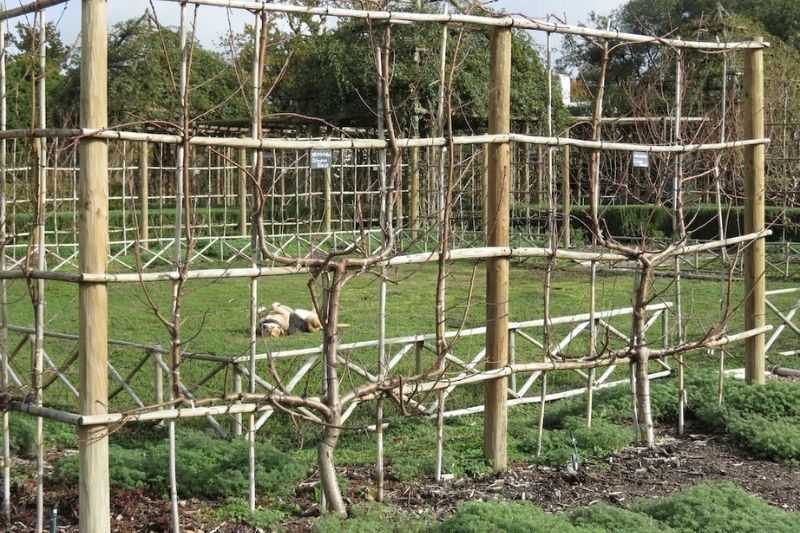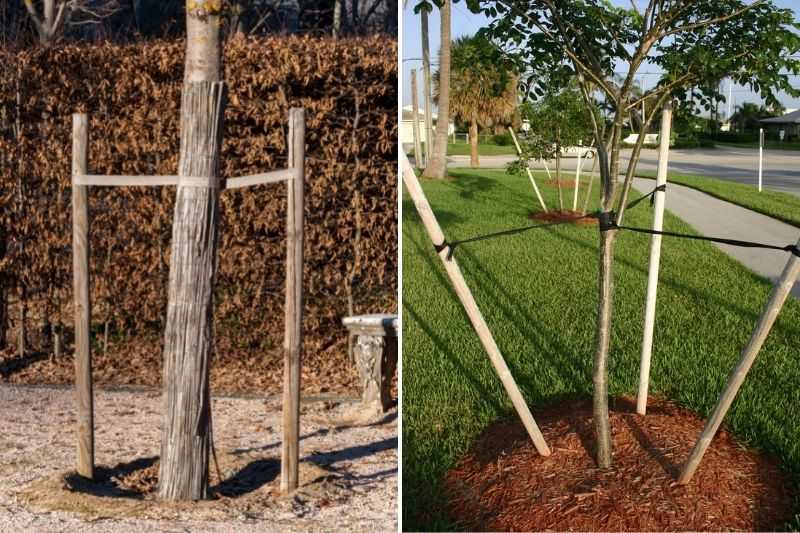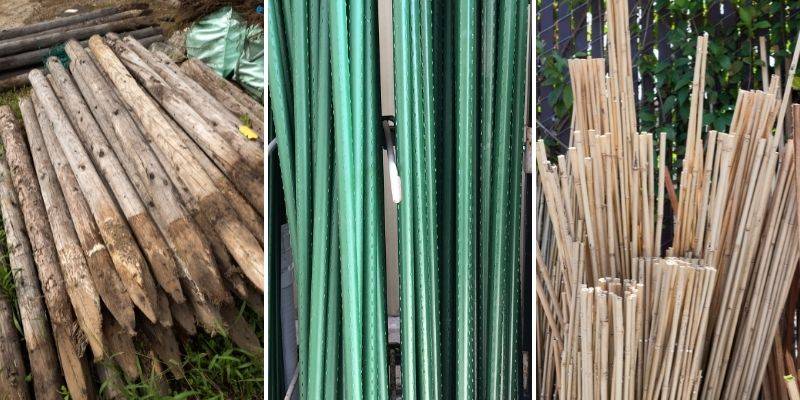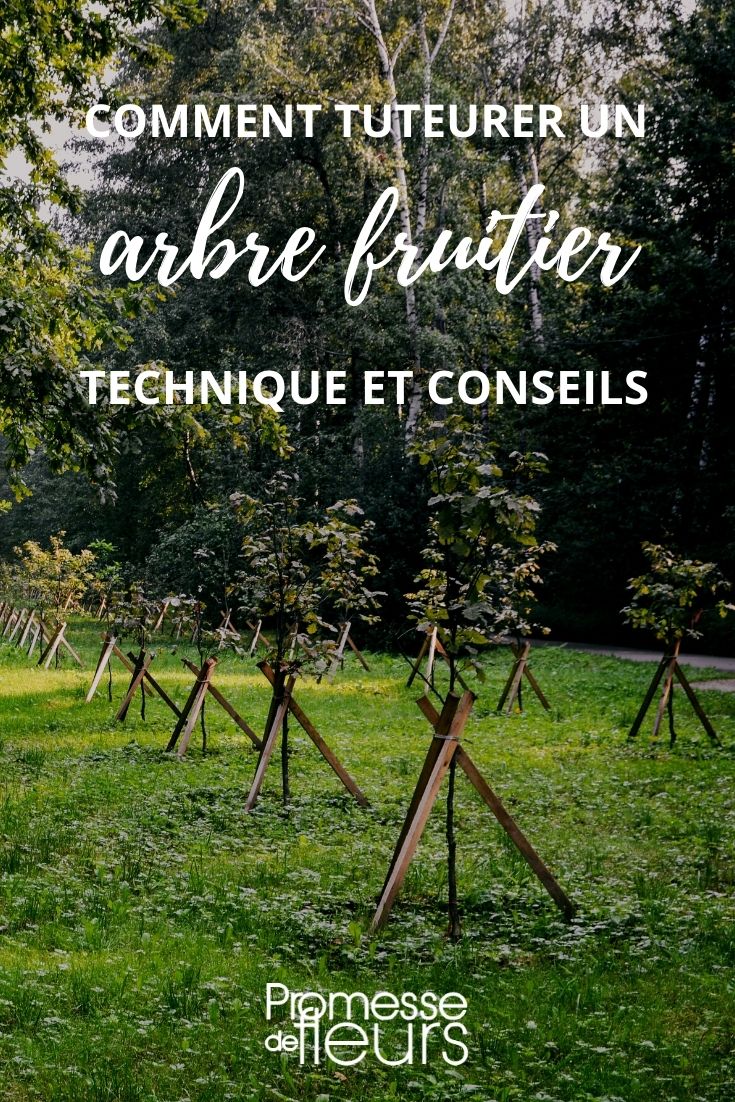Young fruit trees usually need staking to grow straight and encourage root establishment.
Certain ground conditions particularly require staking: sloping terrain, gardens exposed to strong winds or storms, unstable or loose soil (sandy, silty), or particularly wet ground.
Similarly, trees with a reduced root system relative to their branches or a trunk that is too thin and fragile will need support to anchor them and grow stably.
Let’s explore the different staking methods, the necessary materials, and the steps to properly stake fruit trees without hindering their natural development.

Espalier fruit trees (photo Malcom Manners)
When to stake a fruit tree?
The stake should be installed just before planting the fruit tree, to avoid damaging the roots. Staking beforehand allows the tree to grow straight and upright, guided despite future wind and rain exposure.
An unstaked tree planted several years ago, which has not grown straight and upright, will be difficult, if not impossible, to straighten.
The stake should remain in place for about a year, two years maximum, before being removed. This time is necessary for the fruit tree to establish its roots properly.
Conversely, a stake left too long risks damaging the roots or bark of the tree, or even obstructing sap flow if the tie becomes too tight over time.
Different types of staking
There are various techniques for staking fruit trees. They should be adapted and chosen based on the tree’s age, dimensions, trunk diameter, and environmental constraints.
- Simple or monopodium staking, which we will detail in this article, is generally sufficient for a young fruit tree up to 3 or 4 metres in height, with a trunk less than 10 cm in diameter.
- Double or bipod staking involves installing two stakes on either side of larger trees, supported by horizontal planks.
- Tripod and quadripod (or multipod) staking is done by installing 3 or 4 stakes in a triangle or square around the tree, supported by horizontal planks.
- Guying is used for often large trees planted in isolation and/or exposed to severe weather, such as certain resinous trees. It involves installing anchor points around the tree (stakes or braces), connected to the trunk by taut ropes or cables.
- Finally, espaliering is a staking method with or without a frame, primarily used to guide branch growth and shape the silhouette of trees or bushes.

Double and tripod staking (photo Alabama Extension)
Choosing the necessary materials
Different types of stakes
When choosing a stake for a fruit tree, size and diameter are essential: the diameter should ideally be 5 to 10 cm, and the height should reach two-thirds of the trunk’s height, staying below the first branches.
There are different types of guying:
- Untreated, rot-resistant wooden stakes, such as chestnut or hazel, which are natural, sturdy, and durable;
- Plastic or steel-plated stakes, economical, rigid, easy to find, but less eco-friendly;
- Bamboo stakes, natural, decorative, and resistant for a few years (3 to 4 years on average).
Reclaimed concrete reinforcement bars are sturdy and particularly durable, but their diameter is usually too small to provide proper staking.
Similarly, avoid pruned branches that are too flexible and thin, as they may bend and fail to provide adequate support.

Wooden, plastic, and bamboo stakes
Different types of ties
Several types of ties and fasteners are specially designed for staking. The key is always to choose flexible, high-quality fastenings that won’t injure or damage the tree’s trunk.
Opt for:
- Plastic or foam staking collars with a ratchet system for good adjustment;
- Flexible rubber ties like Tree fix, or even reclaimed inner tubes;
- Metal ties only if they are wrapped in foam or elastomer, such as Biflex or Toltex;
- Willow ties.
Avoid thin plastic strings or ties, as they are not durable, lack robustness, and can even injure the bark.

Foam, rubber, and foam-wrapped metal ties
Steps to properly stake a fruit tree
Depending on how the tree is packaged (container-grown or bare-root), the stake will be placed diagonally or straight, parallel to the trunk.
To install the stake:
- Dig the planting hole and water the soil;
- Place the fruit tree in the chosen orientation;
- Install the stake about 15 cm from the trunk, facing the prevailing wind to ensure stability and protect the tree from gusts;
- Insert the stake at a 45° angle for a container-grown tree (to avoid damaging the root ball), or vertically for a bare-root tree;
- Remove the tree to drive the stake safely using a mallet, to a depth of about 50 cm, ideally deeper than the tree’s roots;
- Plant the fruit tree, then backfill the hole;
- Attach the stake to the trunk at mid-height using a tie, forming a figure-eight: the tie is first looped around the trunk, then crossed over to the stake. This prevents direct contact between the stake and trunk and avoids friction. If the stake is tall, add ties every 50 cm or so;
- Water generously to encourage establishment.

The tie forms a figure-eight around the trunk and the diagonally placed stake.
After staking
Ideally, each season:
- Check the stake’s stability and condition;
- Adjust the tightness of the ties, so they don’t end up compressing the trunk as it thickens during growth.
Mistakes to avoid for successful staking
- Driving the stake into the tree’s root ball or directly into the roots.
- Tightening the ties too much, strangling the trunk and preventing the tree from swaying slightly and thriving properly.
- Forgetting to remove the stake and tie after two years maximum, which can hinder growth and proper root system development.































Comments